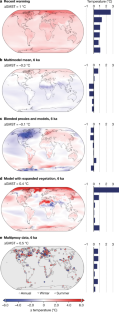2023-02-20 アリゾナ大学
◆化石燃料の燃焼によって加速される地球温暖化の影響は、広く立証されている。将来の気候変動を予測するために、研究者はしばしば過去の気候や環境の変化に関する情報を参照し、気候システムの感度を示すとともに、過去の気温変化の影響を理解しようとする。そのために、高度なコンピューターモデルと、地球の地質学的記録に記録されている過去の気候の証拠に頼っている。
◆この2つの証拠は、過去数千年にわたる気温のトレンドについて一致していないのだ。過去6,000年の気候モデルによるシミュレーションでは、一般的に温暖化が進んでいるが、堆積物、年輪、サンゴなど、地球上の自然のアーカイブに保存されている地質学的データは、一般的に徐々に寒冷化していることを示しているのだ。このようなモデルと自然のアーカイブとの間の地球規模の「温度の難問」が、『Nature』誌に掲載された総説の主題である。論文の著者は、北アリゾナ大学地球環境学部のリージェンツ教授であるDarrell Kaufman氏と、アリゾナ大学年輪研究所の博士研究員であるEllie Broadman氏である。
<関連情報>
- https://news.arizona.edu/story/global-warming-was-earth-cooling-down-or-heating
- https://www.nature.com/articles/s41586-022-05536-w
完新世の地球気温の難問を再考する Revisiting the Holocene global temperature conundrum
Darrell S. Kaufman & Ellie Broadman
Nature Published:15 February 2023
DOI:https://doi.org/10.1038/s41586-022-05536-w

Abstract
Recent global temperature reconstructions for the current interglacial period (the Holocene, beginning 11,700 years ago) have generated contrasting trends. This Review examines evidence from indicators and drivers of global change, as inferred from proxy records and simulated by climate models, to evaluate whether anthropogenic global warming was preceded by a long-term warming trend or by global cooling. Multimillennial-scale cooling before industrialization requires extra climate forcing and major climate feedbacks that are not well represented in most climate models at present. Conversely, global warming before industrialization challenges proxy-based reconstructions of past climate. The resolution of this conundrum has implications for contextualizing post-industrial warming and for understanding climate sensitivity to several forcings and their attendant feedbacks, including greenhouse gases. From a large variety of available evidence, we find support for a relatively mild millennial-scale global thermal maximum during the mid-Holocene, but more research is needed to firmly resolve the conundrum and to advance our understanding of slow-moving climate variability.



